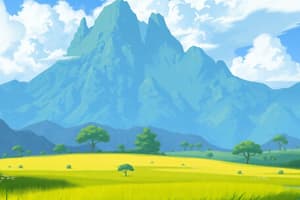Podcast
Questions and Answers
Name two types of desert vegetation and explain how they are adapted to survive in arid conditions.
Name two types of desert vegetation and explain how they are adapted to survive in arid conditions.
Succulent plants and shrubs. Succulent plants store water in their stems and leaves, while shrubs are adapted to survive in arid environments.
List three species of mammals found in temperate grasslands and three species of mammals found in deserts.
List three species of mammals found in temperate grasslands and three species of mammals found in deserts.
Temperate grasslands: Bison, elk, pronghorn antelope. Deserts: Desert bighorn sheep, kangaroo rats, rattlesnakes.
What are the main characteristics of desert climates, and how do they impact the vegetation in deserts?
What are the main characteristics of desert climates, and how do they impact the vegetation in deserts?
Low rainfall, high temperatures, little vegetation. The harsh climate forces plants to adapt to arid conditions, resulting in sparse vegetation.
Flashcards are hidden until you start studying
Study Notes
Temperate Grasslands and Deserts
Temperate grasslands and deserts are two distinct types of ecosystems found in different regions of the world. Each of these ecosystems has unique characteristics and supports a diverse range of animal species.
Temperate Grasslands
Temperate grasslands are large, flat areas with grasses, as well as some flowers and shrubs, in a climate with cold winters and warm summers. They are typically found in the central parts of continents where the climate is dry and the rainfall is low. While not as diverse as tropical grasslands, temperate grasslands still host a variety of plant and animal species.
Climate
The climate of temperate grasslands is characterized by:
- Cold winters: Temperatures can drop significantly, and snow cover is common.
- Warm summers: Temperatures can reach highs of 20–30 °C (68–86 °F) in the summer.
- Low precipitation: Rainfall is generally low, with most rain occurring during the summer months.
Vegetation
Temperate grasslands are dominated by grasses, which are adapted to the harsh climate. Some common grass species include big bluestem, little bluestem, and Indian grass. Shrubs and flowering plants are less common but still present, such as prairie cordgrass, sand cordgrass, and beach grass.
Animal Life
Temperate grasslands support a diverse range of animal species, including:
- Mammals: Bison, elk, pronghorn antelope, and prairie dogs are among the larger mammals found in temperate grasslands. Smaller mammals include coyotes, foxes, and rabbits.
- Birds: Grassland birds like the western meadowlark, greater prairie-chicken, and Henslow's sparrow inhabit these ecosystems.
- Reptiles and Amphibians: Rattlesnakes, garter snakes, and bullfrogs are some of the reptile and amphibian species found in temperate grasslands.
- Insects: Grasshoppers, crickets, and various beetles are common insects in these ecosystems.
Deserts
Deserts are ecological landscapes characterized by aridity, with low rainfall and high temperatures. There are two main types of deserts: hot and cold. Hot deserts have high temperatures and low rainfall, while cold deserts have low temperatures and moderate rainfall.
Climate
Deserts are characterized by:
- Low rainfall: Rainfall is generally less than 10 inches (25 cm) per year.
- High temperatures: Hot deserts can have temperatures exceeding 100 °F (38 °C) during the summer. Cold deserts have lower temperatures, but still experience extreme heat during the day and cold at night.
- Little vegetation: Due to the harsh climate, plants are sparse and adapted to survive in arid conditions.
Vegetation
Desert vegetation is adapted to the harsh climate and includes:
- Succulent plants: These plants store water in their stems and leaves to survive in arid conditions. Examples include cacti and agaves.
- Shrubs: Desert shrubs like creosote bush, juniper, and sagebrush are adapted to survive in the arid environment.
- Annual plants: These plants grow quickly during rainy periods and then die when conditions become dry again.
Animal Life
Deserts support a diverse range of animal species adapted to the harsh climate:
- Mammals: Desert bighorn sheep, kangaroo rats, and rattlesnakes are some of the larger mammals found in deserts. Small mammals include jerboas, kangaroo mice, and pocket mice.
- Birds: Desert birds like the roadrunner, desert tortoise, and cactus wren inhabit these ecosystems.
- Reptiles and Amphibians: Lizard species like Gila monsters and venomous snakes like rattlesnakes are common in deserts. Amphibians like the desert toad and the desert spadefoot toad are also found in these ecosystems.
- Insects: Desert insects like the desert ant, the sidewinder tarantula, and the Mojave desert centipede are well-adapted to the arid conditions.
In conclusion, temperate grasslands and deserts are two distinct types of ecosystems found in different regions of the world. Each of these ecosystems has unique characteristics and supports a diverse range of plant and animal species adapted to the specific climate conditions.
Studying That Suits You
Use AI to generate personalized quizzes and flashcards to suit your learning preferences.




